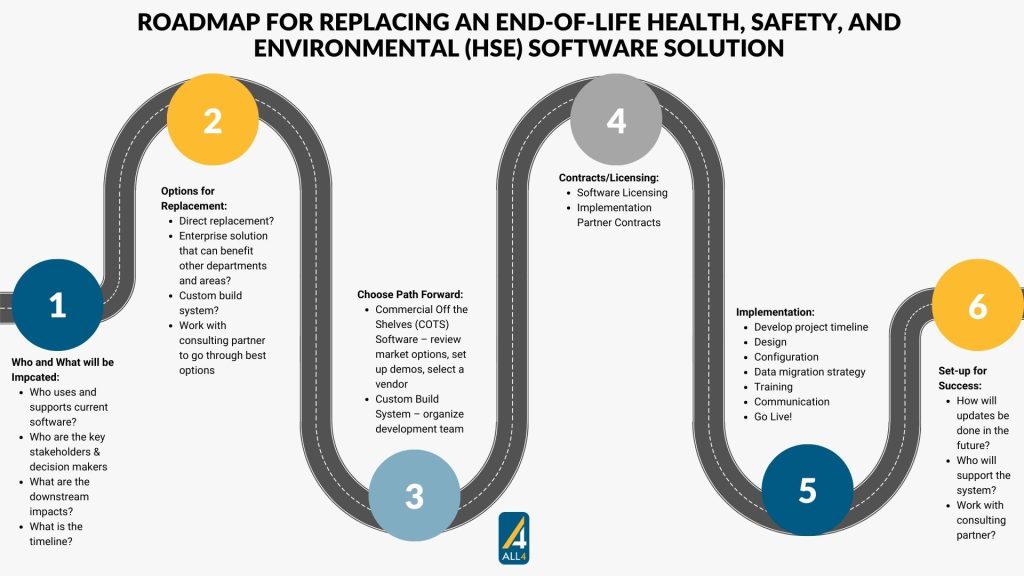Roadmap for Replacing an End-of-Life Health, Safety, and Environmental (HSE) Software Solution
Posted: March 14th, 2024
Authors: Kaitlin G.
Have you been told your Health, Safety, and Environmental (HSE) software will no longer be supported? As software companies continue to evolve, so do their solutions, which leads to the inevitable emergence of new programs and the departure of the old. While losing a working solution is never ideal, it can be a great opportunity to improve existing processes.
Once you have heard a software tool will be discontinued, it is important to start developing an exit strategy to give your team plenty of time to plan the next steps, avoid missing regulatory reporting deadlines, reduce disruption to your user base, and to ensure that the company continues to stay in compliance.
If you have found yourself having to replace an established software tool, here is a high-level roadmap that your team can leverage to help make your company’s transition as stress-free as possible.

Identify Who and What will be Impacted
One of the key steps in effectively replacing an HSE software solution and avoiding unwanted roadblocks is identifying who and what will be impacted, and when it will take place.
- Who is using the current system and will be impacted by the change (i.e., business areas, departments, specific country locations)?
- Identify key stakeholders and decision makers and get them involved. This is especially important when considering what budget discussions and approvals may need to be considered.
- Who supports the current system (i.e., IT, EHS, consultants)? Start having discussions with these teams and keep them part of the conversation going forward.
- What other upstream or downstream systems are currently being used (i.e., integrations, Power BI) that may be impacted?
- When will the software stop being supported, and when would a new solution need to be in place? This is a good time to start drafting out a timeline and identify drivers such as regulatory reporting dates, the date for sunsetting the previous software, budget approvals, internal resource capacity/capabilities, etc.
- Does the company have specific security-related IT policies that could impact moving forward such as single sign-on or specific auditability requirements?
Identify Options for Replacement
ALL4 can help take out some of the guesswork of this stage. As a professional Digital Solutions Practice that has done many projects of this type before, we can help your team identify current and future-state business and technical requirements to consider in moving forward without the current software, while helping explore the industry’s current offerings and providing an unbiased perspective on the best tools for your organization.
Some items to start considering:
- Does it make sense to do a direct replacement of the existing system, or are there other departments within the company that could benefit from an investment in new software?
- What are the benefits and efficiencies of implementing new software while the current system is still functioning? This could include parallel reporting, giving the ability to reference the old while learning the new, and providing end users time to adjust without it being time critical.
- Customizability versus configurability of software: what makes the most sense for your company? What are the pros/cons?
- What budget do you have available? The perfect solution may be out there, but if budgetary constraints inhibit your options you may decide to plan for the expense early in the process.
- How urgent is the replacement? The answer to this question will help you gauge the feasibility of implementing different solutions and determine what to include in the initial project scope.
Choose a Path Forward
Once you have gathered all the potential options for replacement, it is time to decide. Depending on what the decision is, this step will look different for everyone. If you are replacing software, the next step is determining what software options exist and which is the best fit. If you are going a different route, such as building an in-house solution or using spreadsheets, you will want to get the appropriate resources organized to develop the plan to design and implement your new solution.
ALL4 can support your team through the software selection process. Our DSP team has extensive experience and industry knowledge, including subject matter experts (SME) across various states and HSE areas, and our team has implementation experience and partnerships with a variety of software vendors. ALL4 can:
- Provide vendor suggestions that can support identified business requirements and help set up appropriate vendor demos.
- Help ask vendor questions and offer professional guidance. We are familiar with the market and understand the areas of strength for various digital solutions.
- Assist in evaluating vendors against business and technical requirements, identifying potential gaps.
- Support developing a Request for Proposal (RFP) for vendors and/or implementation partners.
- Bring in a change management resource to support your team with a successful transition.
Get Contracts and Licensing in Order
If your replacement decision includes purchasing new software and/or including an implementation partner, it is time to get those contracts ironed out. Depending on who you are working with it can take time to come to licensing agreements and implementation contracts, and internal and legal reviews can add time to getting contracts signed. The sooner your project can get any contractual negotiations started and signed, the sooner the project can kick off.
Implement the Replacement
Whether you’re working with an implementation partner, vendor services team, or an internal team, now is the time to finalize the timeline, organize internal resources, and start progressing on the implementation process. Here are a few examples of what should happen in this phase:
- Develop an implementation timeline, start designing the new system (or process, forms, spreadsheets), and address necessary business and technical requirements during the design.
- Get the design approved by key decision makers and start configuration.
- If migrating data, figure out how data can be extracted from the old system and in what format, along with what kinds of data transformation may need to occur. If not migrating, decide where historical data will be stored and accessed in the future. Learn more about ALL4’s legacy data migration planning and approach here.
- Start building end user excitement and buy in and decide on how to roll out training. This is an area where a change management specialist can provide value.
- Train your system administrators and end users and go live!
- Once the new process is in place and confirmed to be working, finalize any data migration or archiving that needs to occur and retire the old system.
Set-up for Success
During the implementation, start having conversations on how your company will support the new software post go-live. To set up the new system for on-going success, you’ll want to have a long-term sustainment plan in place identifying who and how will the software be maintained and updated. Some options to consider:
- Does your internal team have the knowledge and resources to manage the software?
- Are you going to rely on the vendor when system changes are needed?
- Will you work with a consulting partner, like ALL4?
- Has the project been properly documented to ease knowledge transfers?
Following this roadmap can help your company move through the process of replacing an End-of-Life software solution. It is critical that you start looking into alternatives as soon as you can, so that you do not end up making rushed decisions or risk being out of compliance. A longer process greatly reduces the risk of causing stress to your team and end users and impacting the success of your project. If you would like to discuss further, please contact Kaitlin George at kgeorge@all4inc.com or 585-687-2124.

